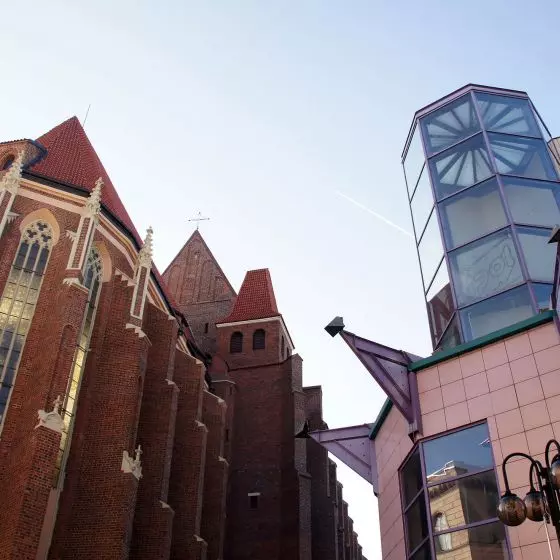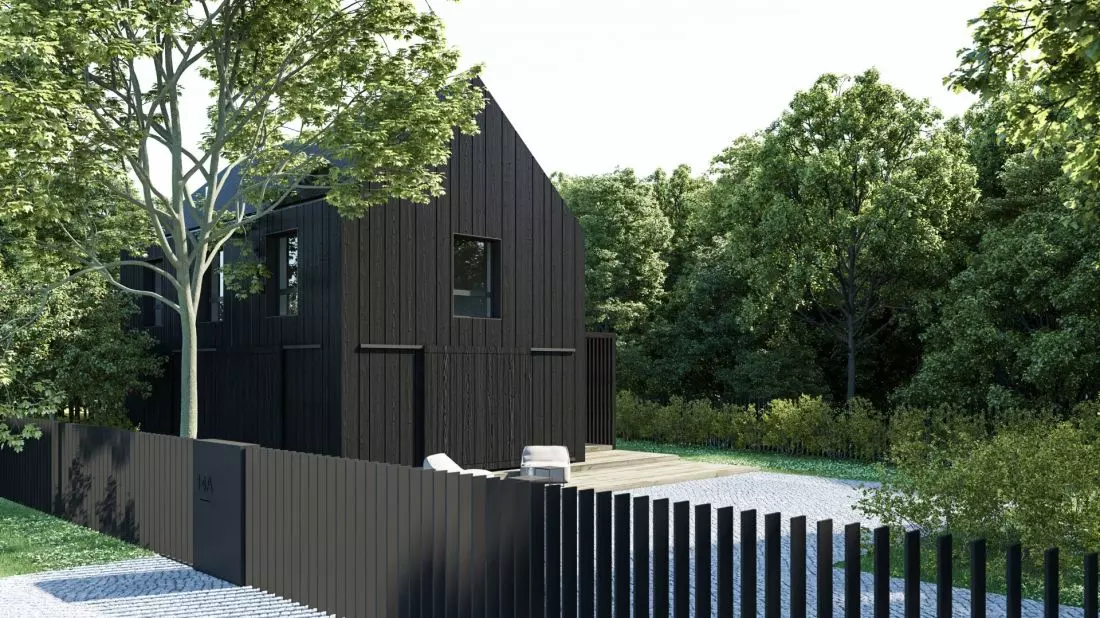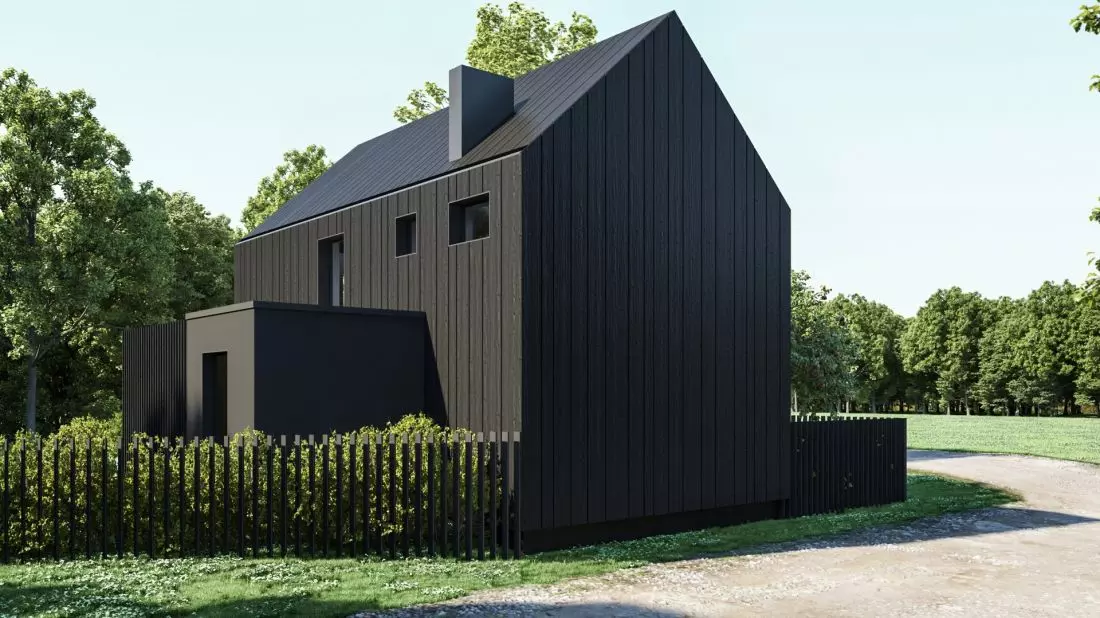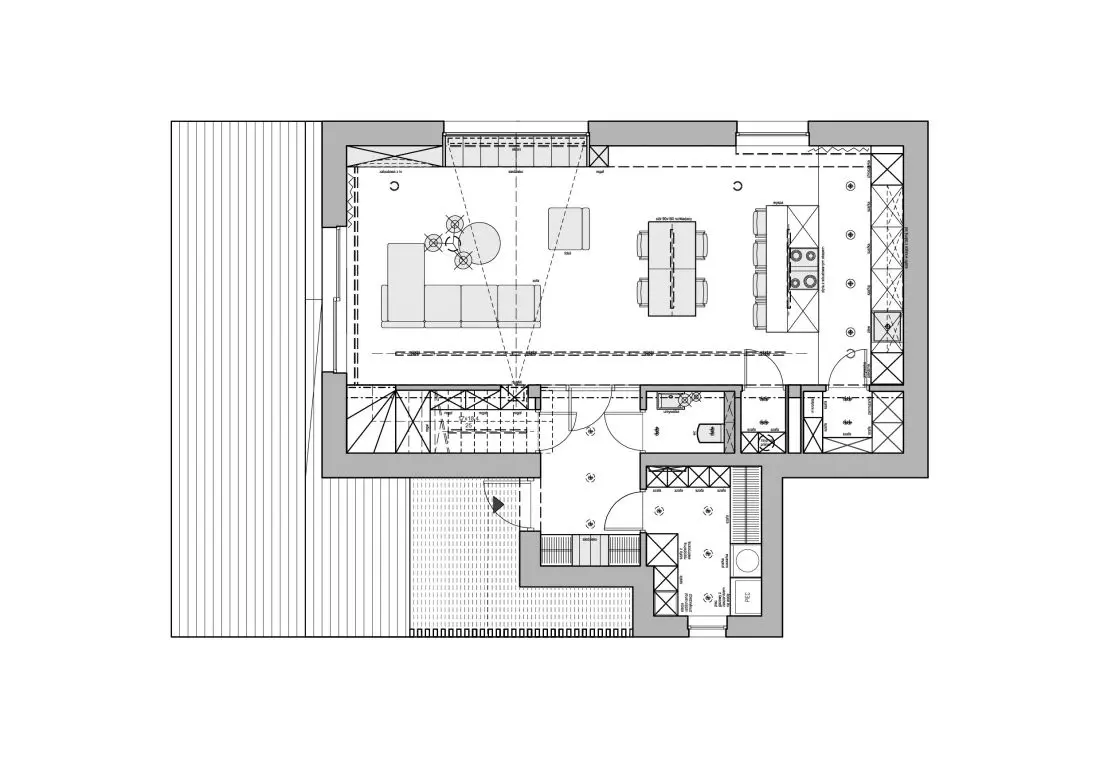Anna Maria Sokolowska, an architect and owner of an interior design studio, decided to fulfill her dream of converting an old farm building into a home of her own. The idea turned out to be not so easy to realize, and finding a dream plot in the vicinity of the Tricity even more difficult, fortunately, Rumia and two buildings from the 1940s appeared.
Can a house become a love story? Why not, especially if it is love at first sight. Maybe not exactly for the house, but for the view I saw the first time I came to inspect the plot [...]. Rumia near Gdynia was not my first choice for living, so I delayed for a long time before looking at another property. When I arrived at the site in April 2017, the excitement let go and I already knew that this would be my place on earth," says Anna Maria Sokolowska.
The architect decided to turn a farm building into a modern barn
© Anna Maria Sokolowska Interior Architecture
Enchantment with Rumia
The plot of land with an unusual shape and an area of 1340 square meters, which Anna Maria Sokolowsa bought, is located in a district of Rumia called Szmelta, surrounded by the picturesque valley of the Zagorska Struga River. There were two buildings on the site to be demolished or renovated - a residential house from 1947 and an outbuilding with a living room from 1940.
I knew from the beginning that demolition of the two buildings was out of the question, because it was for them that I bought the plot and, of course, for the view," adds the architect.
The design goal was the former farm building
Photo: Anna Maria Sokolowska Interior Architecture
The owner decided to leave the residential house, and her design goal became the farm building. The building consisted of one living room with a tiled stove, a bathroom added in the 1990s, and a barn with a separate entrance and a ladder leading to a wooden loft where hay was stored.
Stodolove refers to the black barns
© Anna Maria Sokolowska Interior Architecture
discovering history
The process of buying the plot of land and acquiring all the documents took a long ten months, during which time the architect had the space to learn about the history of the place and the village. As it turned out, the valley in which the plot is located was a valley of mills, and along the river there are still old farm buildings preserved, which took the form of black barns - their boards were usually covered with tar to protect them from moisture and pests.
The architect began the project by learning about the history of the site
© Anna Maria Sokolowska Interior Architecture
Therefore, wanting to preserve the rural character of the place, I decided to remodel the building in the style of the farm buildings of the area. It was natural for me to create from the existing farm building, a barn covered entirely with black tan board. I used Siberian larch as roofing and Scandinavian spruce for the facade. I created an archive based on old maps, photos from the 19th century and photos of modern farm buildings that have survived in the area. The challenge turned out to be even more complicated, as the plot was the first from which conservation supervision was established in the area. For the existing building, a comparative analysis had to be made in terms of the historic building that is located in the area (for which the local plan was written), an analysis of the existing building and the building after reconstruction. The challenge was greater because it was the first time I had to deal with such a requirement for a plan. The comparative analysis, however, was nothing compared to the excavations the builder did for us after I purchased the plot. What was left of my dreams of saving the outbuilding was the foundation and three sections of brick walls, which had to be replaced with a higher-density material during the reconstruction anyway, because the brick was waste from the brickyard and would crumble with a slight blow from a hammer. That's how I went from a romantic hovel to a remodeling, an expansion with superstructure to a much greater extent than the initial plan," says the author.
The house is a black, simple block with a gabled roof
© Anna Maria Sokolowska Interior Architecture
formerly an outbuilding, now a house
On the land occupied by the two properties grow old fruit trees, and next to the house itself, a spreading walnut tree, behind which the body of the building hides in summer. The building in question is quite narrow - its shorter elevation on the side of the yard is 6.8 meters long, and that on the street side is 11.5 meters. The entrance to the house was placed at the back and is not visible from the street. The architect was keen to fit into the context of the place, hence the black, simple body with a gabled roof covered with board, board on the facade and black sliding shutters, on the first floor, referring in form to the barn gate.
First floor planning began with a storefront with a seat
© Anna Maria Sokolowska Interior Architecture
It was important to the owner that the floor of the house be full, without a loft - hence the almost complete use of the available height of 9 meters. Planning the layout of the first floor, on the other hand, began quite unusually, as from the showcase with a seat, which is the center of the entire living space, and it was under it that the layout of the other windows was laid out.
In accordance with the principle of modernism and functionalism, "form follows function," the design of the facade was preceded by the layout of the functionality in the building, to this only the rhythm of the windows on the facade was adjusted, so that the whole had a coherent character, the author adds.
construction is scheduled for completion in spring 2022
© Anna Maria Sokolowska Interior Architecture
interview with Anna Maria Sokolowska
Dobrawa Bies: Why did you choose the Tri-City area in particular to build your dream house?
Anna Maria Sokołowska: I am a native of Gdynia, almost of three generations (my grandmother was five years old when my family moved to Gdynia before the war) my mother was born in Gdynia, so was I, and so was my son. As an architect, I am very attached to Gdynia's modernism, and I have had my own studio in Gdynia for 16 years, and I also live here. Therefore, the natural choice was the Tri-City or the surrounding area. The barn in Rumi is 14 km from the center of Gdynia and from my studio.
Dobrawa: What were your main design goals?
Anna Maria: To adapt the farm building to the needs of a modern family, while respecting the tradition and history of the place. To fit the building into the context of the place, so that its remodeled form and black board facade would blend in with the surroundings and surrounding greenery, and not create an aggressive impact. This is what I cared about most. I didn't want to make the barn into a contemporary house with all glass walls, balconies and terraces. I cared about purity of form and showing that inscribing a utilitarian function into a farm building can be done while respecting its traditional form. Once a fellow architect asked me why the house did not have any balconies or terraces, I answered with the question - Does the barn have a balcony?
The designer was keen to show that inscribing a utilitarian function into a farm building,
can be implemented while respecting its traditional form
© Anna Maria Sokolowska Interior Architecture
Dobrawa: What do you think the phenomenon of the barn house is based on?
Anna Maria: The majority of zoning regulations or provisions of the local plan impose a gable or multi-pitch roof, most often with a slope of up to 45 degrees, which usually forces the form and does not give much room for interpretation, although I know of some projects where it was possible to conceal the roof slope in a simple shape in a clever way. I will frankly admit that as an architect born and raised in Gdynia, a city that was created from scratch as a creation of modernism, I could not imagine owning any other house than a modernist, simple block. My preferences changed over time, although, as I said, I was also looking for objects that were more industrial than in a ruralist climate, but these two directions became closer to me once I knew what I cared about most. The phenomenon of the barn house (at least with me) came from the fact that over the years I have observed many very successful adaptations of farm buildings into residential houses, first in foreign realizations then they began to appear in Poland as well. Simple body, gabled roof - assumed to be cheap to build, without problematic breakages as in the case of multi-pitched roofs, without dormers and bay windows.
floor plan
© Anna Maria Sokolowska Interior Architecture
Dobrawa: Is designing for yourself more difficult than designing for a commission?
Anna Maria: Designing for myself is like a conversation of a schizophrenic. I - the architect, tries to convince the I - the client of the ideas, and the conversation between the architect and the client goes on in the head. Also, the multitude of decisions that need to be made, especially when, you are in the industry (I had a bigger problem with interiors than with massing) spends sleep. When you design for a client, you have a live person on the other side, you see how they react to proposals, there are emotions, there is interaction, dialogue, joint choices and arguments on both sides. It's definitely easier to work when you have conviction in your arguments and are able to convey them in a matter-of-fact way, which are not lined with a large dose of various, often extreme emotions that appear when you design for yourself. When I "go into" a client's project, everything sets up very smoothly for me, when I'm not sure about something, I make two versions and ask the client which one he likes better and together we can agree on the final version. It is that second, objective voice that is missing when designing for myself.
Dobrawa: Thank you for the interview.




















































